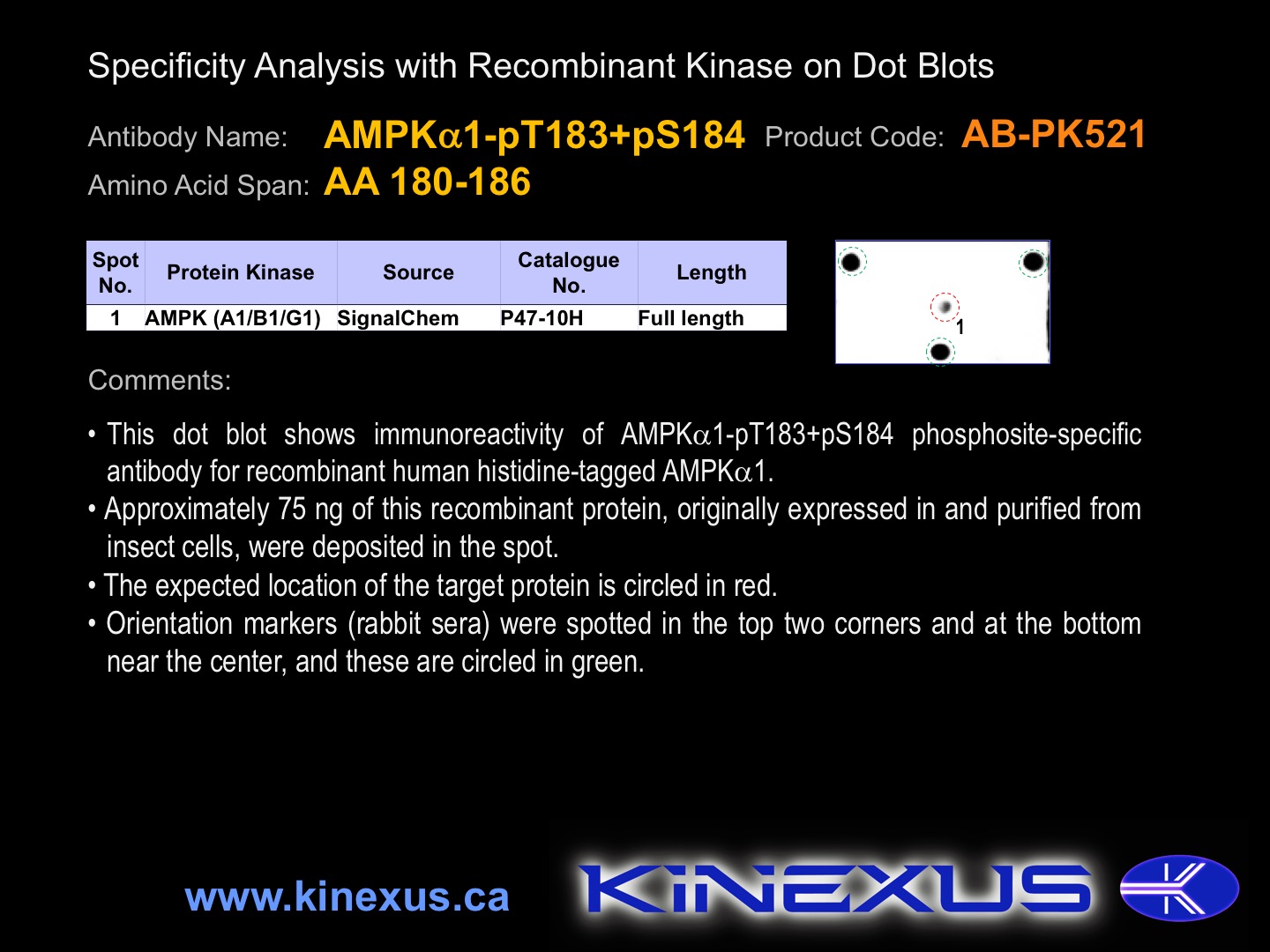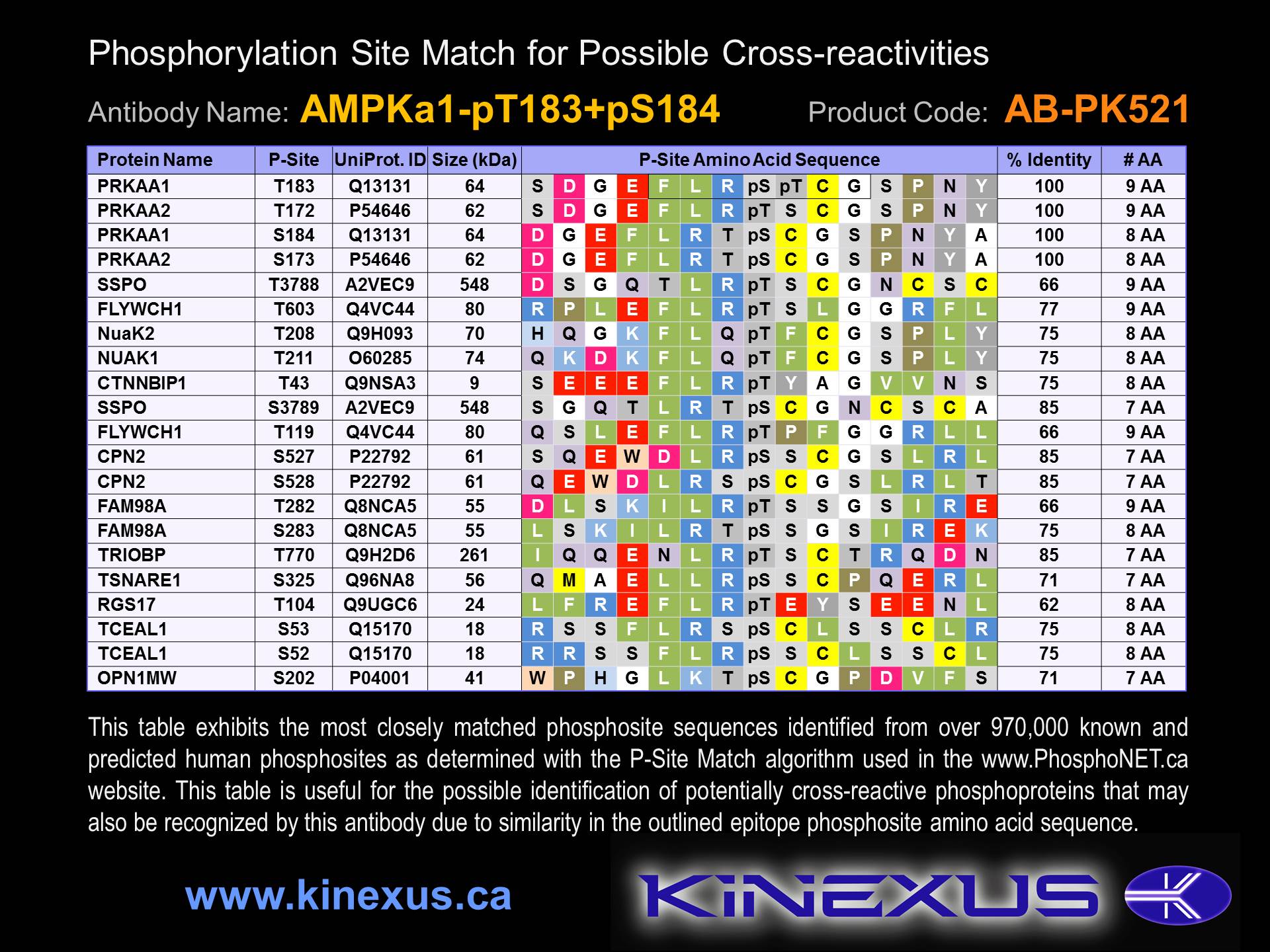Product Name: AMPKa1-pT183+pS184
Product Number: AB-PK521
| Size: | 25 µg | Price: | 89.00 | |
| $US |
Target Full Name: 5'-AMP-activated protein kinase catalytic subunit alpha-1
Target Alias: 5'-AMP-activated protein kinase, catalytic alpha-1 chain; AAPK1; Acetyl-CoA carboxylase kinase; AMPK alpha-1 chain; AMPK, alpha, 1; AMPK-alpha1; HMG-CoA reductase kinase; HMG-CoA reductase kinase; PRKAA1; Protein kinase, AMP-activated, alpha 1 catalytic subunit; MGC33776; MGC57364; CCDS3932.1; ENSG00000132356
Product Type Specific: Protein kinase phosphosite-specific antibody
Antibody Code: PK521
Antibody Target Type: Phosphosite-specific
Antibody Phosphosite: T183+S184
Protein UniProt: Q13131
Protein SigNET: Q13131
Target Alias: 5'-AMP-activated protein kinase, catalytic alpha-1 chain; AAPK1; Acetyl-CoA carboxylase kinase; AMPK alpha-1 chain; AMPK, alpha, 1; AMPK-alpha1; HMG-CoA reductase kinase; HMG-CoA reductase kinase; PRKAA1; Protein kinase, AMP-activated, alpha 1 catalytic subunit; MGC33776; MGC57364; CCDS3932.1; ENSG00000132356
Product Type Specific: Protein kinase phosphosite-specific antibody
Antibody Code: PK521
Antibody Target Type: Phosphosite-specific
Antibody Phosphosite: T183+S184
Protein UniProt: Q13131
Protein SigNET: Q13131
Antibody Type: Polyclonal
Antibody Host Species: Rabbit
Antibody Immunogen Source: Human AMPKa1 (PRKAA1) sequence peptide Cat. No.: PE-04AIG99
Antibody Immunogen Sequence: FLR(pS)(pT)CG(bA)C
Antibody Immunogen Description: Corresponds to amino acid residues F180 to G186; In protein kinase catalytic domain activation T-loop between subdomains VII and VIII.
Antibody Host Species: Rabbit
Antibody Immunogen Source: Human AMPKa1 (PRKAA1) sequence peptide Cat. No.: PE-04AIG99
Antibody Immunogen Sequence: FLR(pS)(pT)CG(bA)C
Antibody Immunogen Description: Corresponds to amino acid residues F180 to G186; In protein kinase catalytic domain activation T-loop between subdomains VII and VIII.
Production Method: The immunizing peptide was produced by solid phase synthesis on a multipep peptide synthesizer and purified by reverse-phase hplc chromatography. Purity was assessed by analytical hplc and the amino acid sequence confirmed by mass spectrometry analysis. This peptide was coupled to KLH prior to immunization into rabbits. New Zealand White rabbits were subcutaneously injected with KLH-coupled immunizing peptide every 4 weeks for 4 months. The sera from these animals was applied onto an agarose column to which the immunogen peptide was thio-linked. Antibody was eluted from the column with 0.1 M glycine, pH 2.5. Subsequently, the antibody solution was neutralized to pH 7.0 with saturated Tris.This antibody was also subject to negative purification over phosphotyrosine-agarose.
Antibody Modification: Unconjugated. Contact KInexus if you are interest in having the antibody biotinylated or coupled with fluorescent dyes.
Antibody Modification: Unconjugated. Contact KInexus if you are interest in having the antibody biotinylated or coupled with fluorescent dyes.
Antibody Concentration: 1 mg/ml
Storage Buffer: Phosphate buffered saline pH 7.4, 0.05% Thimerasol
Storage Conditions: For long term storage, keep frozen at -40°C or lower. Stock solution can be kept at +4°C for more than 3 months. Avoid repeated freeze-thaw cycles.
Product Use: Western blotting | Antibody microarray
Antibody Dilution Recommended: 2 µg/ml for immunoblotting
Antibody Potency: Weak immunoreactivity of a target-sized protein by Western blotting in insulin-stimulated MCF7 cells. Very strong immunoreactivity with immunogen peptide on dot blots.
Antibody Species Reactivity: Human
Storage Buffer: Phosphate buffered saline pH 7.4, 0.05% Thimerasol
Storage Conditions: For long term storage, keep frozen at -40°C or lower. Stock solution can be kept at +4°C for more than 3 months. Avoid repeated freeze-thaw cycles.
Product Use: Western blotting | Antibody microarray
Antibody Dilution Recommended: 2 µg/ml for immunoblotting
Antibody Potency: Weak immunoreactivity of a target-sized protein by Western blotting in insulin-stimulated MCF7 cells. Very strong immunoreactivity with immunogen peptide on dot blots.
Antibody Species Reactivity: Human
Antibody Positive Control: The observed molecular mass of the processed target protein on SDS-PAGE gels is reported to be around 60-65 kDa.
Antibody Specificity: Medium
Antibody Cross Reactivity: No significant cross-reactivities detected in HeLa except phenylarsine oxide (PAO) increase detection of a 27 kDa protein; in Jurkat cells, phenylarsine oxide (PAO) decrease 100 kDa protein and phenylarsine oxide (PAO) increase 15 kDa protein. This antibody appears to cross-reacts with CDK1 in sea star oocytes.
Related Product 1: AMPKa1-pT183+pS184 blocking peptide
Related Product 2: AMPKa1-AKCD pan-specific antibody (Cat. No.: AB-NK259-1)
Related Product 3: AMPKa2-AKCD1 pan-specific antibody (Cat. No.: AB-NK260-2)
Antibody Specificity: Medium
Antibody Cross Reactivity: No significant cross-reactivities detected in HeLa except phenylarsine oxide (PAO) increase detection of a 27 kDa protein; in Jurkat cells, phenylarsine oxide (PAO) decrease 100 kDa protein and phenylarsine oxide (PAO) increase 15 kDa protein. This antibody appears to cross-reacts with CDK1 in sea star oocytes.
Related Product 1: AMPKa1-pT183+pS184 blocking peptide
Related Product 2: AMPKa1-AKCD pan-specific antibody (Cat. No.: AB-NK259-1)
Related Product 3: AMPKa2-AKCD1 pan-specific antibody (Cat. No.: AB-NK260-2)
Related Product 4: AMPKa1 (PRKAA1) protein kinase substrate peptide
Related Product 5: AMPKSelectide - AMPKa1 (PRKAA1) protein kinase substrate peptide
Related Product 6: AMPKSubtide - AMPKa2 (PRKAA2) protein kinase substrate peptide
Related Product 7: AcCoACarbox (73-85) S77A, KinSub - Acetyl-Coenzyme A carboxylase alpha (H73-R85, mouse) peptide; AMPKA protein kinase substrate; SAMStide
Related Product 8: GSK3b (3-12) KinSub - Glycogen synthase kinase 3-beta (GSK3b) N-terminus (G3-E12, human) peptide; Akt protein kinase substrate peptide
Related Product 5: AMPKSelectide - AMPKa1 (PRKAA1) protein kinase substrate peptide
Related Product 6: AMPKSubtide - AMPKa2 (PRKAA2) protein kinase substrate peptide
Related Product 7: AcCoACarbox (73-85) S77A, KinSub - Acetyl-Coenzyme A carboxylase alpha (H73-R85, mouse) peptide; AMPKA protein kinase substrate; SAMStide
Related Product 8: GSK3b (3-12) KinSub - Glycogen synthase kinase 3-beta (GSK3b) N-terminus (G3-E12, human) peptide; Akt protein kinase substrate peptide
Scientific Background: AMPKa1 (PRKAA1) is a protein-serine/threonine kinase of the CAMK group and CAMKL family. AMP-activated protein kinase (AMPK) exhibits a key role as a master regulator of cellular energy homeostasis. AMPK exists as a heterotrimeric complex composed of a catalytic alpha subunit and regulatory beta and gamma subunits. Binding of AMP results in allosteric activation, inducing phosphorylation on T183 by STK11 in complex with STE20-related adapter-alpha (STRAD alpha) pseudo kinase and CAB39. AMPK is activated in response to stresses that deplete cellular ATP (low glucose, hypoxia and ischemia) and via signalling pathways in response to adiponectin, leptin and CAMKK-beta. Phosphorylation at T174 by CAMKK1 and CAMKK2 increases phosphotransferase activity, triggered by a rise in intracellular calcium ions, without detectable changes in the AMP/ATP ratio.
Figure 1. Dot blotting AMPKa1-pT183+pS184 antibody with recombinant purified proteins.
Figure 2. Identification of phosphosites related to AMPKa1-pT183+pS184.
© Kinexus Bioinformatics Corporation 2017



